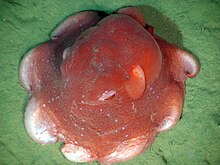Opisthoteuthis californiana
| Flapjack octopus | |
|---|---|

| |
| Scientific classification | |
| Domain: | Eukaryota |
| Kingdom: | Animalia |
| Phylum: | Mollusca |
| Class: | Cephalopoda |
| Order: | Octopoda |
| Family: | Opisthoteuthidae |
| Genus: | Opisthoteuthis |
| Species: | O. californiana
|
| Binomial name | |
| Opisthoteuthis californiana | |
Opisthoteuthis californiana, also known as the flapjack octopus[3] or adorabilis,[4] is a species of umbrella octopus.
Description
The flapjack octopus usually appear dark red.[5] They have fins above their eyes, similar to those found on some species of squid. Their maximum size is 20 centimetres (7.9 in) mantle length.[5] They have eight jointed legs which are affixed together in an umbrella shape.[6] They have a gelatinous body, which spreads into a parachute shape when maneuvering through dimly lit water.[6] The flapjack preys on small fishes and planktonic crustaceans.[5] They swim by moving their fins, pulsing their webbed arms, pushing water through their funnel for jet propulsion, or all three at once.[7] Their depth range is: Para-larvae 200 metres (660 ft), adults 500–1,500 metres (1,600–4,900 ft).[5]
Distribution
This species has been reported off Eureka Bar, California, at 350 metres (1,150 ft). It is also known from Japan, off Kashima-Nada, at 530–560 metres (1,740–1,840 ft).[8] Nesis (1982/87) reports it from the Bering Sea to the Sea of Okhotsk to off central Honshū.
Reproduction
The female gender of the Opisthoteuthis californiana produces and hatches around 200-500 eggs.[citation needed] The male gender of the flapjack octopus would perform different kinds of sexual rituals to attract the females.[citation needed] Once the eggs hatch, the hatchlings stay around with their mother for a brief period of time before they are old enough to grow to the benthic stage and survive by itself.[citation needed]
Classification
The Opisthoteuthis californiana is one of 14 species in the genus Opisthoteuthis. These species are also collectively known as the flapjack devilfishes.[9]
Species of Opisthoteuthis are the most compressed, in the anterior-posterior axis, of any cephalopod. This flattened appearance gives them the common name of flapjack or pancake devilfish. Species are thought to be primarily benthic although they are capable of swimming and in some species the swimming may be an important component of their pouncing on minute prey. As in other cirrates, most species are poorly known.
Diet
The Flapjack Octopus feeds on small fish, planktons, crustaceans, and worms.
These octopuses are quite capable of hunting and killing their prey. They do so by pouncing on their prey and killing them with their beaks.[citation needed] They are known as the flapjack octopus because they compress themselves, appearing more flattened, therefore acting non-hostile to their prey.[citation needed] Using this technique, they are able to hunt their prey.
Against predators, they hide through crevices and under rocks.[citation needed]
Popular culture
ChuChu from Kirby's Dream Land 3 is a flapjack octopus. In Finding Nemo, one of Nemo's classmates, Pearl, is a flapjack octopus.[10] Lenny the flapjack octopus is the main character in a children's book The Adventures of a Flapjack Octopus.[11]
References
- ^ Lyons, G.; Allcock, L. (2014). "Opisthoteuthis californiana". The IUCN Red List of Threatened Species. 2014: e.T163065A968048. doi:10.2305/IUCN.UK.2014-3.RLTS.T163065A968048.en. Downloaded on 07 February 2018.
- ^ Philippe Bouchet (2018). "Opisthoteuthis californiana Berry, 1949". World Register of Marine Species. Flanders Marine Institute. Retrieved 7 February 2018.
- ^ "Steller Sea Lion and Northern Fur Seal Research: Environmental Impact Statement". 22 November 2017. Retrieved 22 November 2017 – via Google Books.
- ^ Conrad, Caitlin (2015-07-17). "'Adorabilis' octopus on display at Monterey Bay Aquarium". KSBW. Retrieved 2020-11-05.
- ^ a b c d Jorgensen, Elaina (2009). Field Guide to Squids and Octopods of the Eastern North Pacific and Bering Sea. Fairbanks, Alaska: Alaska Sea Grant College. pp. 69–70. ISBN 978-1-56612-139-2.
- ^ a b Dodrill, Tara (June 16, 2015). "Flapjack Octopus". Inquisitr.com. Retrieved June 28, 2016.
- ^ "Flapjack Octopus". Monterey Bay Aquarium Research Institute. Retrieved November 20, 2015.
- ^ "Opisthoteuthis californiana". Tolweb.org. Retrieved 22 November 2017.
- ^ Lamprell, K. L.; Scheltema, A. M.; Healy, J. M. (22 November 2017). Mollusca: Aplacophora, Polyplacophora, Scaphopoda, Cephalopoda. Csiro Publishing. ISBN 9780643067073. Retrieved 22 November 2017 – via Google Books.
- ^ Harmon, Katherine. "Unusual Octopods: A Flapjack Devilfish Octopus [Video]". Scientific American Blog Network. Retrieved 2020-02-24.
- ^ Watson, Charles; Thompson, Wendy Louise (2020). The Adventures of a Flapjack Octopus. New York: Austin Macauley. ISBN 9781528984089.
External links
- "CephBase: Opisthoteuthis californiana". Archived from the original on 2005-08-17.
- Photo of a Flapjack Octopus taken at 400 m depth.

